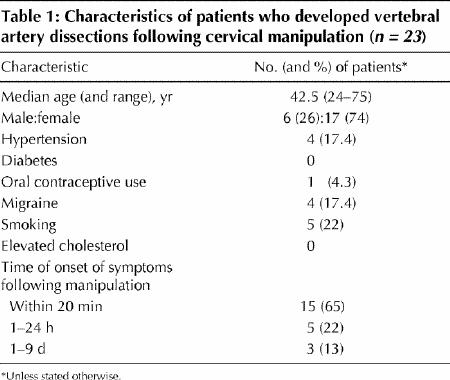Research into the effectiveness of spinal manipulation1,2 has resulted in some acknowledgement of its use by independent agencies in Canada,3 the United States,4 the United Kingdom5 and Denmark,6 which has led to increased integration of chiropractors into mainstream health care delivery systems. This increased acceptance has led to greater interest in the potential complications of spinal manipulation and, in particular, the occurrence of arterial dissection following cervical manipulation.
Recent surveys have suggested that it is not uncommon for neurologists, particularly those with a specific interest in stroke, to treat patients who have developed a vertebral artery dissection following cervical manipulation.7,8 In this study, we attempted to obtain an estimate of the rate of stroke following manipulation from a chiropractic perspective.
Following approval by the Institutional Review Board of the Canadian Memorial Chiropractic College in Toronto, Ont., a review of malpractice data from the Canadian Chiropractic Protective Association (CCPA) was carried out to evaluate all claims of stroke following chiropractic care for the 10-year period between 1988 and 1997. All case files were reviewed in order to determine the type of associated cerebrovascular event and the characteristics of the patients who experienced these complications. The diagnosis by the treating neurologist, which was obtained from the records, was used to determine the nature of the stroke. This was compared with the number of cervical manipulations performed each year by chiropractors covered by the CCPA. This denominator was obtained from a survey questionnaire that was completed for one week of practice by 10% of the practising chiropractors in Canada. The effective response rate was 77.8%. These data were extrapolated by multiplying the median number of visits in which a cervical manipulation was administered by the number of chiropractors in the survey group, and using a figure of 49.1 weeks of practice per year obtained from a previous survey. The results of the extrapolation suggested that approximately 134.5 million cervical manipulations were performed by chiropractors covered by the CCPA during this period.
There were 43 cases of neurological symptoms following cervical manipulation over the 10-year period. Of these, 20 were minor and were not diagnosed as stroke by a neurologist. Twenty-three cases of stroke or vertebral artery dissection following cervical manipulation were reported. The frequency of hypertension, diabetes, use of oral contraceptives, migraine headaches and smoking in these 23 patients is shown in Table 1.
Table 1

There are over 4500 licensed chiropractors in Canada. The likelihood that a chiropractor will be made aware of an arterial dissection following cervical manipulation is approximately 1:8.06 million office visits, 1:5.85 million cervical manipulations, 1:1430 chiropractic practice years and 1:48 chiropractic practice careers. This is significantly less than the estimates of 1:500 000–1 million cervical manipulations calculated from surveys of neurologists.7,8,9 These data also confirm the conclusions of a recent review of the literature in which patients at risk for this complication could not be identified.10
It is probable that the experience of chiropractors does not reflect all dissections that occur following cervical manipulation. Unfortunately, earlier surveys of neurologists did not review patient charts to determine the type of manipulation that was administered or even whether a manipulation was performed during the chiropractic visit implicated in the dissection. The only manner in which the real incidence of dissection following cervical manipulation can be established and the feasibility of screening patients determined is to carry out research in which both chiropractors and neurologists participate. Failure to cooperate in such research will result in confusing and conflicting information being given to patients and will reduce the likelihood that these complications can be avoided.
Footnotes
This article has been peer reviewed.
Competing interests: None declared for Dr. Townsend. Dr. Haldeman has reviewed files or cases involving the Canadian Chiropractic Protective Association (CCPA) as an outside independent consultant. Dr. Carey is president of the CCPA and is in charge of claims, files and management on behalf of the CCPA. Mr. Papadopoulos was an employee of the Canadian Chiropractic Association until the spring of 2001.
Correspondence to: Dr. Paul Carey, 89 Waterloo St. S, Stratford ON N5A 4B1; fax 519 273-4161; pfcarey@golden.net
References
- 1.Aker PD, Gross AR, Goldsmith CH, Pelosa P. Conservative management of mechanical neck pain: systematic overview and meta-analysis. BMJ 1996; 313:1291-6. [PMC free article] [PubMed]
- 2.Hurwitz EL, Aker PD, Adams AH, Meeker WC, Shekelle PG. Manipulation and mobilization of the cervical spine. A systematic review of the literature. Spine 1996;21:1746-60. [DOI] [PubMed]
- 3.Spitzer WO, Skovron ML, Salmi LR, Cassidy JD, Duranceau J, Suissa S, et al. Scientific monograph of the Quebec Task Force on Whiplash-Associated Disorders: redefining “whiplash” and its management [published erratum appears in Spine 1995;20(21):2372]. Spine 1995;20 (Suppl 8):1S-73S. [PubMed]
- 4.Coulter ID, Hurwitz EL, Adams AH, Meeker WC, Hansen DT, Mootz RD, et al. The appropriateness of manipulation and mobilization of the cervical spine. Santa Monica (Calif): RAND Corporation; 1996.
- 5.Rosen M, Breen A, Hamann W, Harber P, Jayson MIV, Kelly E, et al. Management guidelines for back pain. Report of a clinical standards advisory group committee on back pain. London: Her Majesty's Stationery Office (HMSO); 1994.
- 6.Manniche C, Ankjær-Jensen A, Olsen A, Fog A, Williams K, Biering-Sørensen F, et al. Low-back pain: frequency, management and prevention from an HTA perspective. Copenhagen: Danish Institute for Health Technology Assessment; 1999. Available: http://147.29.115.214/publikationer/docs/Low-back%20pain/default.html (accessed 2001 Aug 27).
- 7.Lee KP, Carlini WG, McCormick GF, Albers GW. Neurologic complications following chiropractic manipulation. A survey of California neurologists. Neurology 1995;45:1213-5. [DOI] [PubMed]
- 8.Norris JW, Beletsky V, Nadareishvili ZG, on behalf of the Canadian Stroke Consortium. Sudden neck movement and cervical artery dissection. CMAJ 2000; 163(1):38-40. Available: www.cma.ca/cmaj/vol-163/issue-1/0038.htm [PMC free article] [PubMed]
- 9.Stroke after chiropractic manipulation, a “small but significant risk” study finds. American Heart Association News 1994;Feb 19:1-3.
- 10.Haldeman S, Kohlbeck FJ, McGregor M. Risk factors and precipitating neck movements causing vertebrobasilar artery dissection after cervical trauma and spinal manipulation. Spine 1999;24(8):785-94. [DOI] [PubMed]


